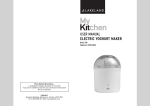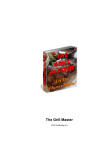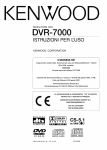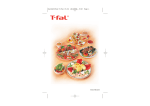Download - pint.com.au
Transcript
Tasting notes From The Enthusiast™ (by Flavor Active) - Beer Taste Troubleshooting Kit. Sampled on the 14th of June 2008 at the pint.com.au Beer Day Out. This is a compilation of the tasting notes from the Beer Day Out. In all 10 people participated on the day tasting all 8 tainted Beers against control beers (Imported German Becks). Below are the tasting notes included with the kit followed by the notes taken by the participants on the day. If anyone is interested in purchasing one of these kits they are available from beertown.org. Thanks to everyone who participated in the tasting for making their notes available. 1. Metal Contamination. Notes from the Flavour Active™ kit: Problem If your beer tastes like this, it has been tainted by contact with poor quality metallic brewing equipment. Most commonly such flavours are caused by ferrous ions (from iron or steel). However, occasionally other metal ions, or even not-metallic flavour substances are involved. What can I do with the batch? It may be possible to mask the flavour by adding some other strong flavour to the beer. Consider making a fruit beer from this batch by adding a commercial fruit essence. Or if the flavour intensity isn’t too strong, try blending it with another beer that doesn’t have the problem. How do I prevent this happening again? Avoid using poor quality equipment, especially equipment made from mild steel. Problems like this can also occasionally happen with equipment of sound quality when it is new. Such equipment needs either a period of use, or ‘passivation’ by treatment with strong acid to prevent metal pick-up by the beer. Other stuff The flavour in the beer is: Ferrous ion: a tinny, blood-like character. Aside from having a distinctive flavour, ferrous ions affect beer in other ways. They will make your beer foam more stable. But they will also speed up the development of haze and oxidation flavours. Tasting notes from the pint.com.au Beer Day Out Barry – Definitely tasted a metallic flavour. Stuart – The control beer has a slight grainy aroma with a prominent hop aroma. The doctored beer reduced the hop aroma and the metal contamination was strong and overpowering. Tinny. James – Pipey, bloody, rusty, Kynton mineral water. Tastes Healthy!! Ebony – Blood nose. Iron. Metallic after taste lingures. Mineral water flavour. Can’t pick it up in smelling. Not completely disgusting. Phil – Like Angkor – metal taint. Aluminiumny old can flavour; aroma slightly flatter. This is the central problem in Cambodian beer. Worse on back palate. Megan – The taste of the Cambodian beer Angkor, rusty undertones and a bit bloody. Stays on the tongue like a bastard, but isn’t overly offensive. Hanna – Metal contaminant very strong on the tongue, can pick up a small amount on the nose. Nathan – Flat bland feeling at end of taste. Minerals are easy to feel on palate in middle and back of tongue. Nyc – Very strong taste of metal. Acid like. Slight or no aroma associated. Ben – Get a similar taste from hot water sometimes. Definitely blood like (i.e. like biting tongue). Lingers. 2. Spoilage by acetic acid bacteria. Notes from the Flavour Active™ kit: Problem If your beer tastes like this it has been spoiled by acetic acid bacteria. These could be either Acetobacter species or Gluconobacter species. What can I do with the batch? Destroy it. There is little you can do to improve its flavour, and while you have it around you risk spreading the problem to your other beers. However, if you are feeling adventurous you could always make vinegar from it. How do I prevent this happening again? There are two main contributors to this problem: 1. Dirty Equipment. 2. Exposure of beer to air. The first is relatively easy to deal with – sterilise all your equipment before use, either with chemicals or heat. The second can be addressed by maintaining a blanket of CO2 on the beer at all times during and after fermentation. Avoid splashing of beer during transfers from one vessel to another. Finally, make sure the headspace on bottled beer isn’t too big. Other stuff The flavour in this beer is: Acetic Acid: a vinegar-like character. Sometimes beers which have been spoiled by acetic acid bacteria turn hazy or cloudy. This is partly due to the presence of many tiny bacterial cells, and partly due to precipitation of protein in the beer as a result of a reduction in beer pH value. Tasting notes from the pint.com.au Beer Day Out Barry – Had a brew turn out like this one recently. Stuart – Very slight acidic/vinegary flavour that increased as the beer warmed. The more I sampled the stronger the vinegary flavour increased. James – Home Brewy. Not outright bad but you wouldn’t want to drink a pint of it. Ebony – Seems to destroy any nice flavours. Bland – bland. As beer warms, ‘tang’ on back of mouth at saliva glands. Phil – Acid burning aroma: vinegary and sulphurous on the back. Beer atrocity. Megan – Dull – Just ‘less’ on initial tasting – gets more unpleasant as you drink on, also tangier but in an unpleasant way. Different mouth feel, also a bit flatter perhaps. Hanna – Tangy at back of tongue. Reduced aromas. Nathan – Tart dry feeling in cheeks, not much flavour in tongue. Taste gets stronger afterwards on back of throat. Nyc – Not very noticeable, either taste or aroma. Ben – Disgusting sour like taste. Vinegar like flavour. Seems to strip some malt and hop flavours out of the beer. Slight furry feeling on top-middle-front part of tongue. 3. Bacterial growth in the mash. Notes from the Flavour Active™ kit: Problem If your beer tastes like this, your mash has suffered bacterial spoilage. Tha bacteria involved most likely belong to one of two groups – Bacillus or Clostridium. What can I do with the batch? These off-flavours are not very flavour-active, so you may be able to blend this beer with another beer that is free of off-flavours to produce something that is quite acceptable. Try blending one part of your problem beer with three parts of another and see if you can still taste the off-flavours. How do I prevent this happening again? Bacteria are present on all malts, and many of them are able to survive and grow at the temperatures used for mashing. Your problem is likely to have arisen from an excessively long mash stand at relatively low temperatures. Next time double-check your mash temperatures and stand times, and stick to them. And make sure the equipment you use for mashing is scrupulously clean. Other stuff The flavour in this beer is: Butyric acid: a flavour reminiscent of baby vomit. Acetic acid: a vinegar-like character. Tasting notes from the pint.com.au Beer Day Out Barry – Tasted baby vomit. Stuart – The overpowering aroma of sweet vomit. The flavour of vomit is slightly less than the aroma and a slight vinegary flavour could be detected. James – Vomit! Ebony – Nose of overripe fruit, rotten synthetic grape, melon, bile, paw-paw. Taste isn’t as bad as smell, no really strong flavours. Phil – Like I’ve just vomited up a whole fruit cake aroma; a bit of fake durian flavour on the front, but not as pronounced as aroma. Slightly more acidic when warmer. Megan – Smells slightly sweeter and fruitier (than control) but not strong at all. Tastes markedly different but not unpleasant – sweeter. Acidic after warming. Hanna – Sweet on the nose, vomity characters on the nose increases. Something nasty at the back centre of the tongue, flavour difficult to isolate. Nathan – Smells like vomit. Lost taste compared to control. Fairly bland on tongue. Nyc – Slight acetic aroma. Not much in the way of acid type tastes. Has calmed some of the control flavours. Ben – Some slight vomit like characters but don’t seem to be picking it up nearly as much as others in the group. Slight rotten grain aroma. Once it warmed up it became fairly disgusting, a lot more like vomit the warmer it got. I also have to put in a quote from Tim at work for this one. This is what he said when he tasted this flavour. “Tastes like you have thrown up and still have bits of vomit stuck up your nose”. 4. Spoilage by wild yeasts. Notes from the Flavour Active™ kit: Problem If your beer tastes like this, it has been spoiled by wild yeasts that belong to the genus Saccharomyces or the genus Brettanomyces. What can I do with the batch? You may be able to blend this beer with another beer that is free of off-flavours to produce something that is quite acceptable. Try blending one part of your problem beer with three parts of another and see if you can still taste the off-flavour. Alternatively, you could think about making an opportunity out of the problem! You’ve produced something that’s half way to being a Weissbier. So why not go the whole way? Brew a Weissbier and blend it with this one to make something special. How do I prevent this happening again? There are three main sources of contamination with these sorts of wild yeasts: 1. Dirty Equipment 2. Contaminated yeast 3. Contaminated air The first is relatively easy to deal with – sterilise all your equipment before use, either using chemicals or heat. Deal with contaminated yeast by replacing it with a fresh supply from a reputable source. Don’t try to acid wash it – acid washing doesn’t kill wild yeasts. Address the risk of contaminated air by keeping the beer covered during fermentation and avoiding putting the fermenter in damp, mouldy areas. Other stuff The flavour in this beer is: 4-Vinyl fuaiacol: a clove-like character. Styrene: a plastic-like flavour. Tasting notes from the pint.com.au Beer Day Out Stuart – I struggled to detect these flavours and aromas. As the beer warmed I detected a slight clove flavour similar to a mild wheat beer flavour. James – Plasticy. Burnt bailing twine. Ebony – Not that offensive. Smell – Can’t pick up much, maybe a slight sarsaparilla / spice odour. Phil – Burnt plastic shopping bag. Maybe some creaminess? Seems to change mouthfeel slightly. Megan – Smells sour, tastes like a wheat beer a bit. Not unpleasant. Hanna – Strong plasticy aroma. Mild plastic aroma. Nathan – Slight PVC pipe smell. Taste slightly creamy like wheat beer. Nyc – Slight plastic aroma. Not very different taste to control. After-taste of rubber. Ben – Not that offensive to me. Tastes a bit rubbery / plastic-like. Does have some clove like flavours or even vanilla notes. Flattens the flavours of the beer. Kind of adds an artificial type sweetness. Another quote from Tim. “Smells like new surfboards”. 5. Bacterial Growth in the fermentation. Notes from the Flavour Active™ kit: Problem If your beer tastes like this, it has been spoiled by growth of bacteria during fermentation. These most likely belong to a group of bacteria that are sometimes called ‘coliforms’. They can include Obesumbacterium proteus and Rahnella aquatilis. What can I do with the batch? Destroy it. There is little you can do to improve its flavour. How do I prevent this happening again? There are three main sources of contamination with coliform bacteria. 1. Dirty equipment 2. Contaminated yeast 3. Contaminated water The first is relatively easy to deal with – sterilise all your equipment before use, using either chemicals or heat. Deal with contaminated yeast by replacing it with a fresh supply from a reputable source, or by acid washing it under carefully controlled conditions. The solution to contaminated water lies in using a good quality supply of potable water, sterilised before use by boiling. Do not dilute cooled wort with cold (unsterilised) water. Other stuff The flavour in this beer is: Indole: a fecal, ‘farmyard’ character. DMS: a character reminiscent of cooked corn. Not all coliform bacteria produce indole in wort. Sometimes only the DMS character is formed. Tasting notes from the pint.com.au Beer Day Out Stuart – This beer had a dull slightly doggy aroma, could not detect DMS. The flavour was slightly of cardboard. James – My Specialty. NQR. Ebony – Unpasteurised milk / biodynamic yoghurt and goat cheese on the nose. Taste is fine, not bad. Phil – Goaty and damp basement. Not hugely offensive at this concentration. Megan – Denser, damp scent – tangy on the back palate. Not unpleasant. Hanna – Can’t pick up any smell. As it got warmer can smell something a bit wet dog. Can still smell some plasticy aroma, maybe from last sample. Something a bit nasty at back middle of the tongue. Nathan – Smells like sour damp beans. Flavour not terrible just more of a lack of taste than anything. Nyc – Not as much aroma as the control. Can not pick any difference in taste. Mouldy after taste that quickly disappears. Ben – Smells a bit like a wet horse or wet hay. Tastes damp / slightly mouldy. Can’t taste much DMS (corn like) flavours. Bit of a dull damp cardboard flavour. 6. Insufficient boiling of wort. Notes from the Flavour Active™ kit: Problem If your beer tastes like this, your wort has been insufficiently boiled. What can I do with the batch? You may be able to blend this beer with another beef that is free of off-flavours to produce something that is quite acceptable. Try blending one part of your problem beer with three parts of another and see if you can still taste the off-flavours. An alternative is to add a small amount (about 5 mg/L) of sulphite to the beer. This can help mask the grainy flavour. However, take care. Some people are sensitive to sulphites, particularly if they have a history of asthma. How do I prevent this happening again? Make sure you achieve a vigorous, rolling boil. Simmering the wort isn’t good enough. And make sure you boil for the correct time (not too short). Other stuff The flavour in this beer is: Isobutyraldehyde: a grainy, nut-like character. DMS: a character reminiscent of cooked corn. Dimethyl trisulfide: an onion-like flavour. Very occasionally, flavour problems like these, although having origins in the boil, may be exacerbated by poor yeast condition. Sluggish yeast is unable to drive of the volotiles formed in wort boiling. Stick to the advice on the Poor Yeast Health sheet just in case. Tasting notes from the pint.com.au Beer Day Out Stuart – A mild corn like aroma when the sample warmed. A slight grainy flavour was present. James – Corniness? NQR. Ebony – Smell – not so strong, slightly ‘metho’. Taste – drying, sharp, weird on the tongue. Phil – Walnuts? Some corn from DMS. Not right, but not offensive either. Megan – Mouthfeel markedly different – less effervescent, strong alcohol smell – dull flavour but does taste like there is stronger alcohol flavours. Hanna – Nice aromas of the control are gone. Something corny and oniony on aroma. Nathan – Not offensive. More of a feel than a taste. Bit of a coating of tongue. Feels like coats tongue and dulls flavours. Nyc – Methylated spirit aroma to a moderate extent. Taste has a slight metallic flavour. Ben – Does have nutty characters. Has a slight corn type character especially on palate. Definitely NQR but hard to describe. Can taste a hint of the onion like flavour. Has knocked out the malt and hop character from the beer making it taste a bit old and dull. 7. Poor yeast health. Notes from the Flavour Active™ kit: Problem If your beer tastes like this, your yeast is sick. Aside from producing an abnormal balance of regular flavours, this also leads to a reduced rate of elimination of sulphur compounds produced in fermentation. What can I do with the batch? You may be able to blend this beer with another beer that is free of off-flavours to produce something that is quite acceptable. Try blending one part of your problem beer with three parts of another and see if you can still taste the off-flavours. If the beer is high in alcohol (>6% vol/vol) you might try storing it for a while after bottling. This won’t affect the intensity of the apple flavour, but it will help to get rid of the sulphury characters. How do I prevent this happening again? Concentrate on the basics. Use a good quality yeast. Make sure that it’s in good condition and not too old. Pitch the right quantity into the fermenter. Be sure to aerate the wort before pitching. Crop the yeast at the right time – not too late, not too early. And store the yeast in a cool place for the shortest possible time prior to the next fermentation. Other stuff The flavour in this beer is: Ethyl hexanoate: an apple-like character. H2S: a smell reminiscent of hard-boiled eggs. Ethanethiol: a character reminiscent of drains. Tasting notes from the pint.com.au Beer Day Out Barry – Definite apple flavour. Stuart – Very strong aroma of rotting apple, like a bad cider. Sulphury. The flavour is of an artificial apple flavour that overpowers the base beer. James –Apples. Cider. Sulphur. Ebony – Old apple smell, sweet, pungent. Milder, warm fruit taste. Phil – Sulphurous, rotting vegies with cabbage on nose. Cider-tasting and not much else. Wrong for a beer. Megan – Worst flaw so far for me. Strong rotten egg/apple smell – taste is very cidery and dominates all other flavours. Hanna – By far the worst so far. Strong Sulphury aroma with hints of apple. Strong drain flavour. YUK. Nathan – Cidery characters. Can’t get the H2S or other flavours apart from apples. Nyc – Half bad/rotton apple smell. Apple tones on the palate. Ben – Cider like character, even fresh apple character. A little bit of egg type sulphur character. Even a pear like character – green pear. Can’t taste the drain like character. 8. Use of old or degraded hops. Notes from the Flavour Active™ kit: Problem If your beer tastes like this, you have used old or degraded hops or hop products to make it. What can I do with the batch? You may be able to blend this beer with another that is free of off-flavours to produce something that is quite acceptable. Try blending one part of your problem beer with three parts of another and see if you can still taste the off-flavour. How do I prevent this happening again? Avoid using hops or hop products that have been stored for more than two years under ideal conditions (4˚C and vacuum packed), or for less time under non-ideal conditions (higher temperatures and/or access to air). Check the hops before use. They should smell aromatic – not cheesy. The risk of problems is also related to the amount of hops used – so be especially careful about your choice of hop when brewing highly-hopped beers. Other stuff The flavour in this beer is: Isovaleric acid: a cheesy flavour, which reminds some people of sweaty socks. The flavour of isovaleric acid in beer depends on pH. Flavour intensity increases at low pH value. For this reason, adjustment of beer pH, by blending with another beer, can prove effective in dealing with this problem. Tasting notes from the pint.com.au Beer Day Out Barry – Taste sweaty socks. Stuart – Prominent aroma of sweaty socks, also an acrid aroma is noticeable. The flavour is less offensive but still exhibits smelly cheese/sock flavours. James – Ever so slightly socky and yeasty. I don’t get this one!! Ebony – Odour of compost bin, old socks, cheese. THE WORST! Makes me gag. Phil – Camembert made from socks. If someone made cheese in prison, I imagine it would smell this way. Sock carries through to flavour. Megan – Smell overwhelmingly bad, strong smell of cottage cheese and sock. Cheese smell is overwhelming. Worst yet! Hanna – Dirty Socks, bad bad cheese aromas. Very strong aromas. Flavour not as strong but rather offensive. Nathan – Old ladies feet. Horrible, makes me want to spew. Stale sweat. Nyc – Mouldy strong cheese aroma followed by acetic hint. Parmesan cheese taste. Awful. Ben – Exactly like the kit notes say. Got cheesy aroma on the nose first followed by an old sock character. The worst, most offensive one out of the lot. Foul, foul, foul.

























